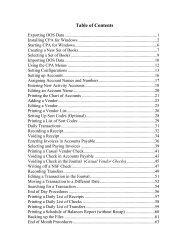Yellow Jacket Times - Jefferson County Public Schools
Yellow Jacket Times - Jefferson County Public Schools
Yellow Jacket Times - Jefferson County Public Schools
Create successful ePaper yourself
Turn your PDF publications into a flip-book with our unique Google optimized e-Paper software.
What’s the most expensive thing you can do? Buy<br />
The Actual Cost of Living<br />
a car? A house? Wed a beautiful woman that likes shiny<br />
Jerry Johnson<br />
things? The answer is none of these. The most expensive<br />
thing you will ever do is die. I’m not talking about that<br />
expensive funeral you’re going to<br />
leave your loved ones. No, I’m<br />
talking about what leads to it.<br />
According to a study by Harvard<br />
in 2005, medical bills are the<br />
cause of over 60 percent of all<br />
bankruptcies. This doesn’t just<br />
happen to people without health<br />
insurance. Even the people with<br />
what the government and CEOs<br />
call “insurance,” can find<br />
themselves in debt from an<br />
unseen hospital stay.<br />
I’m sure I know what you’re<br />
thinking. What causes all these<br />
expenses? Let me start with the small stuff. Information from Pat Palmer, from Medical<br />
Billing Advocates of America, shows the insane costs start with little things. Here are a few<br />
examples. The marking pen, used to mark body parts for surgery, marks up your bill by<br />
$17.50 (no pun intended). One use of a blood pressure cuff, which I learned to use after one<br />
day in a high school pre-med class, will run you $20. Another unnecessary charge is the<br />
“oral administration fee,” or what one might call shipping and handling. Yes, there is a<br />
charge of $87.50 for a nurse to bring you your pills.<br />
Next is most likely the largest impact on the superfluous health care costs. This is the<br />
obvious; the doctor’s cut. The California Association of Health Plans reported that 24% of<br />
hospital bills went to a doctor’s bank account. If you have enough luck and need surgery,<br />
you may need an anesthesiologist. While I’m sure they have a lot more responsibilities, an<br />
anesthesiologist basically gets paid an average of $321,686 per year<br />
(careers.stateuniversity.com) to watch vital signs after they put you to sleep for surgery.<br />
This, along with other doctor fees, also adds to the most convoluted bill you will ever<br />
receive.<br />
I’ve thrown out some stuff that<br />
shows where these costs come from, but I<br />
don’t believe this shows how ridiculous<br />
prices are. To really get your jaw to drop,<br />
here are some numbers. Try to control your<br />
amazement. The average cost per<br />
emergency room visit is $1,327. Keep in<br />
mind, that per does mean just one trip. The<br />
price per outpatient visit will be around<br />
$2,224. That cost rose 10.1% from 2009 to<br />
2010. Then the heavy hitter is inpatient<br />
admissions. For more than what my car is<br />
worth, the average cost for this is a<br />
whopping $14,662. All of these numbers<br />
are brought to you by a report from the Health Care Cost Institute.<br />
It’s a sad time in American history when we have to worry more about medical bills<br />
than medical problems. With over 900,000 people in the beautiful USA going bankrupt from
















